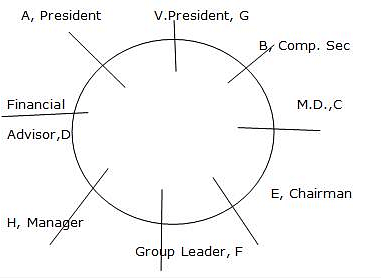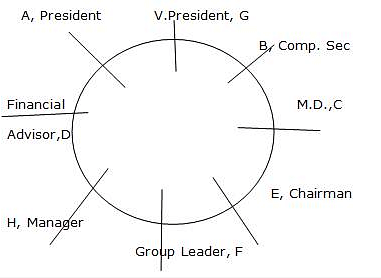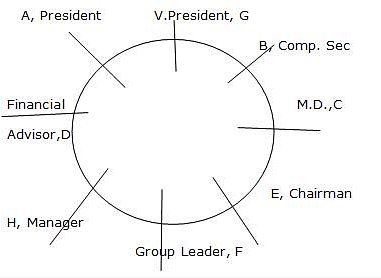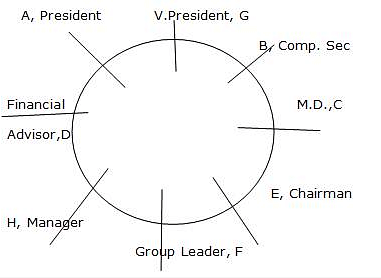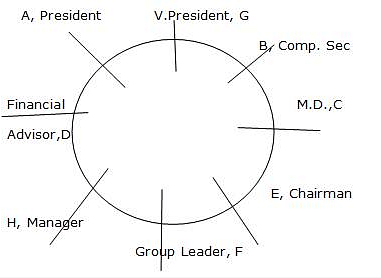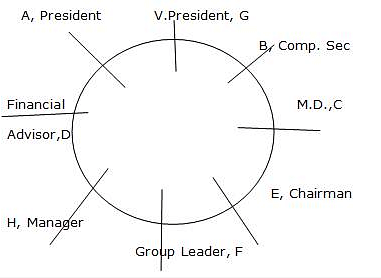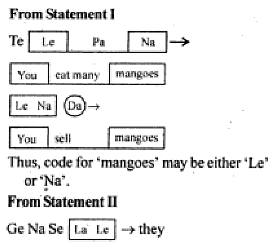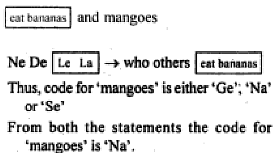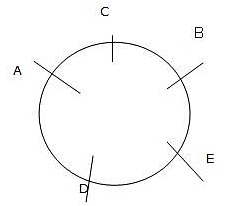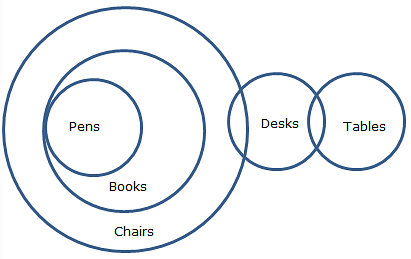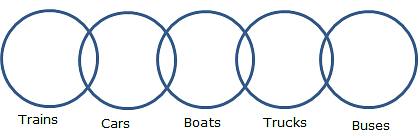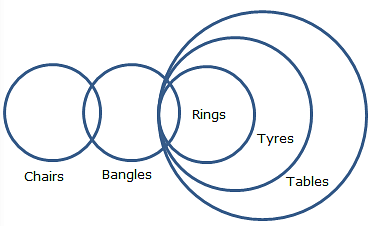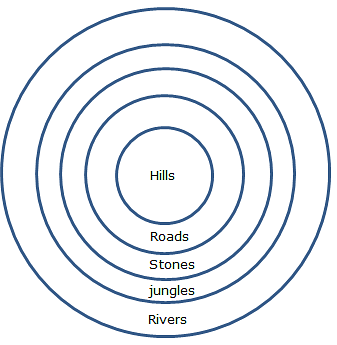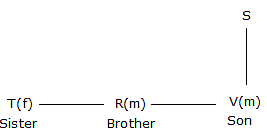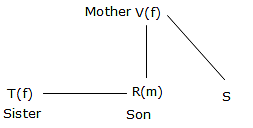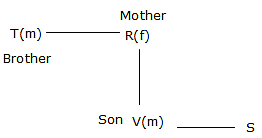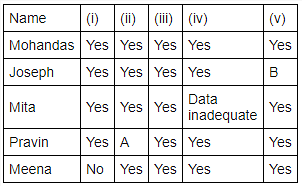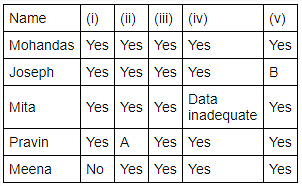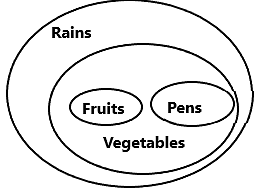MAH-CET MBA Mock Test- 7 - CAT MCQ
30 Questions MCQ Test - MAH-CET MBA Mock Test- 7
If in a certain coding language, 'CHIMERA' is written as '1-18-5-13-9-8-3'. How will 'SPECIES' be written in that code language?
Direction: In making decisions about important questions, it is desirable to be able to distinguish between "strong" arguments and "weak" arguments. "Strong" arguments must be both important and directly related to the questions. "Weak" arguments may not be directly related to the question and may be of minor importance or may be related to the trivial aspects of the question. Each question below is followed by two arguments numbered I and II. You have to decide which of the arguments is "strong" arguments and which is "weak" argument.
Should the retirement age for employees of Central/State Govt. be increased by two years?
I. Yes, this is required in view of the increasing longevity.
II. Yes, experienced employees are more useful than the new recruits.
| 1 Crore+ students have signed up on EduRev. Have you? Download the App |
Directions: Study the following information carefully and answer the given questions.
Eight colleagues, A, B, C, D, E, F, G and H are sitting around a circular table facing the center but not necessarily in the same order. Each one of them holds a different post viz. Manager, Company Secretary, Chairman, President, Vice-president, Group Leader, Financial Advisor and Managing Director.
A sits third to right of the managing director. Only two people sit between the managing director and H. Vice-president and the company secretary are immediate neighbours of each other. Neither A nor H is a vice-president or a company secretary. Vice-president is not an immediate neighbour of the managing director. Manager sits second to the left of E. E is not an immediate neighbour of H. The Manager is an immediate neighbour of both group leader and the financial advisor. Financial advisor sits third to right of B. B is not the vice-president. C sits to the immediate right of the chairman. A is not the chairman. F is not an immediate neighbour of A. G is not an immediate neighbour of the Manager.
Q. Four of the following five are alike in a certain way based on the given arrangement and thus form a group. Which is the one that does not belong to the group?
Directions: Study the following information carefully and answer the given questions.
Eight colleagues, A, B, C, D, E, F, G and H are sitting around a circular table facing the center but not necessarily in the same order. Each one of them holds a different post viz. Manager, Company Secretary, Chairman, President, Vice-president, Group Leader, Financial Advisor and Managing Director.
A sits third to right of the managing director. Only two people sit between the managing director and H. Vice-president and the company secretary are immediate neighbours of each other. Neither A nor H is a vice-president or a company secretary. Vice-president is not an immediate neighbour of the managing director. Manager sits second to the left of E. E is not an immediate neighbour of H. The Manager is an immediate neighbour of both group leader and the financial advisor. Financial advisor sits third to the right of B. B is not the vice-president. C sits to the immediate right of the chairman. A is not the chairman. F is not an immediate neighbour of A. G is not an immediate neighbour of the Manager.
Q. Who amongst the following is the president of the company?
Directions: Study the following information carefully and answer the given questions.
Eight colleagues, A, B, C, D, E, F, G and H are sitting around a circular table facing the center but not necessarily in the same order. Each one of them holds a different post viz. Manager, Company Secretary, Chairman, President, Vice-president, Group Leader, Financial Advisor and Managing Director.
A sits third to right of the managing director. Only two people sit between the managing director and H. Vice-president and the company secretary are immediate neighbours of each other. Neither A nor H is a vice-president or a company secretary. Vice-president is not an immediate neighbour of the managing director. Manager sits second to the left of E. E is not an immediate neighbour of H. The Manager is an immediate neighbour of both group leader and the financial advisor. Financial advisor sits third to the right of B. B is not the vice-president. C sits to the immediate right of the chairman. A is not the chairman. F is not an immediate neighbour of A. G is not an immediate neighbour of the Manager.
Q. Which of the following is true with respect to the given seating arrangement?
Directions: Study the following information carefully and answer the given questions.
Eight colleagues, A, B, C, D, E, F, G and H are sitting around a circular table facing the center but not necessarily in the same order. Each one of them holds a different post viz. Manager, Company Secretary, Chairman, President, Vice-president, Group Leader, Financial Advisor and Managing Director.
A sits third to right of the managing director. Only two people sit between the managing director and H. Vice-president and the company secretary are immediate neighbours of each other. Neither A nor H is a vice-president or a company secretary. Vice-president is not an immediate neighbour of the managing director. Manager sits second to the left of E. E is not an immediate neighbour of H. The Manager is an immediate neighbour of both group leader and the financial advisor. Financial advisor sits third to the right of B. B is not the vice-president. C sits to the immediate right of the chairman. A is not the chairman. F is not an immediate neighbour of A. G is not an immediate neighbour of the Manager.
Q. Which of the following posts does B hold in the company?
Directions: Study the following information carefully and answer the given questions.
Eight colleagues, A, B, C, D, E, F, G and H are sitting around a circular table facing the center but not necessarily in the same order. Each one of them holds a different post viz. Manager, Company Secretary, Chairman, President, Vice-president, Group Leader, Financial Advisor and Managing Director.
A sits third to right of the managing director. Only two people sit between the managing director and H. Vice-president and the company secretary are immediate neighbors of each other. Neither A nor H is a vice-president or a company secretary. Vice-president is not an immediate neighbor of the managing director. Manager sits second to the left of E. E is not an immediate neighbor of H. The Manager is an immediate neighbor of both group leader and the financial advisor. Financial advisor sits third to the right of B. B is not the vice-president. C sits to the immediate right of the chairman. A is not the chairman. F is not an immediate neighbor of A. G is not an immediate neighbor of the Manager.
Q. Who amongst the following sit exactly between the managing director and H?
Directions: Study the following information carefully and answer the given questions.
Eight colleagues, A, B, C, D, E, F, G and H are sitting around a circular table facing the center but not necessarily in the same order. Each one of them holds a different post viz. Manager, Company Secretary, Chairman, President, Vice-president, Group Leader, Financial Advisor and Managing Director.
A sits third to right of the managing director. Only two people sit between the managing director and H. Vice-president and the company secretary are immediate neighbours of each other. Neither A nor H is a vice-president or a company secretary. Vice-president is not an immediate neighbor of the managing director. Manager sits second to the left of E. E is not an immediate neighbor of H. The Manager is an immediate neighbor of both group leader and the financial advisor. Financial advisor sits third to the right of B. B is not the vice-president. C sits to the immediate right of the chairman. A is not the chairman. F is not an immediate neighbor of A. G is not an immediate neighbor of the Manager.
Q. Who amongst the following is the group leader?
Directions: Below is given a passage followed by several possible inferences which can be drawn from the facts stated in the passage. You have to examine each inference separately in the context of the passage and decide upon its degree of truth or falsity.
Economic liberalization and globalization have put pressure on Indian industry, particularly on the service sector, to offer quality products and services at low costs and with high speed.
Organizations have to compete with unequal partners from abroad. It is well recognized that developing countries like India are already behind other countries technologically, in many areas, although some of them particularly India, boast of huge scientific and technical manpower. In addition to this, if an entrepreneur or industrialist has to spend a lot of his time, money and energy in dealing with unpredictable services and in negotiating with the local bureaucracy, it can have a significant dampening effect on business.
Q. No other developing country except India claims that they have highly trained technical manpower.
Directions: Below is given a passage followed by several possible inferences which can be drawn from the facts stated in the passage. You have to examine each inference separately in the context of the passage and decide upon its degree of truth or falsity.
Economic liberalization and globalization have put pressure on Indian industry, particularly on the service sector, to offer quality products and services at low costs and with high speed.
Organizations have to compete with unequal partners from abroad. It is well recognized that developing countries like India are already behind other countries technologically, in many areas, although some of them particularly India, boast of huge scientific and technical manpower. In addition to this, if an entrepreneur or industrialist has to spend a lot of his time, money and energy in dealing with unpredictable services and in negotiating with the local bureaucracy, it can have a significant dampening effect on business.
Q. Foreign companies are more equipped than domestic companies to provide quality service in good time.
Directions: Below is given a passage followed by several possible inferences which can be drawn from the facts stated in the passage. You have to examine each inference separately in the context of the passage and decide upon its degree of truth or falsity.
Economic liberalization and globalization have put pressure on Indian industry, particularly on the service sector, to offer quality products and services at low costs and with high speed.
Organizations have to compete with unequal partners from abroad. It is well recognized that developing countries like India are already behind other countries technologically, in many areas, although some of them particularly India, boast of huge scientific and technical manpower. In addition to this, if an entrepreneur or industrialist has to spend a lot of his time, money and energy in dealing with unpredictable services and in negotiating with the local bureaucracy, it can have a significant dampening effect on business.
Q. Official formalities are less cumbersome in almost all the countries except India.
DIRECTION: In making decisions about important questions, it is desirable to be able to distinguish between "strong" arguments and "weak" arguments. "Strong" arguments must be both important and directly related to the questions. "Weak" arguments may not be directly related to the question and may be of minor importance or may be related to the trivial aspects of the question. Each question below is followed by two arguments numbered I and II. You have to decide which of the arguments is "strong" arguments and which is "weak" arguments.
Should there be a ban on recruiting women employees in companies required to work in night shifts?
I. No, the companies should instead arrange for transport up to the doorsteps of the employees.
II. Yes, it is necessary in view of the increasing number of cases of rape/molestation and cheating.
Directions: Each of the questions below consists of a question and two statements numbered I and II given below it. You have to decide whether the data provided in the statements are sufficient to answer the question.
How is M related to N?
I. P, who has only two kids, M & N, is the mother-in-law of Q, who is sister-in-law of N.
II. R, the sister-in-law of M, is the daughter-in-law of S, Who has only two kids, M &. N,
Directions: Each of the questions below consists of a question and two statements numbered I and II given below it. You have to decide whether the data provided in the statements are sufficient to answer the question.
How many students from the class secured First Class?
I. The number of students securing First Class was equal to the number of students who failed and was one-third of the number of students passed in the class of 120 Students.
II. 1/4 th of the girls, i.e. 10 and 1/4 th of the boys secured Ist class in the class of 120 students.
Directions: Each of the questions below consists of a question and two statements numbered I and II given below it. You have to decide whether the data provided in the statements are sufficient to answer the question.
What is the code for 'mangoes' in a code language?
I. In that code language 'Te Le Pa Na' means 'You eat many mangoes' and 'Le Na Da' means 'You sell mangoes.
II. In the code language 'Ge Na Se La Le' means 'They eat bananas and mangoes' and 'Ne De Le La' means 'Who others eat bananas'.
Directions: Each of the questions below consists of a question and two statements numbered I and II given below it. You have to decide whether the data provided in the statements are sufficient to answer the question. Read both the statements and chose the correct answer:
Are all five friends viz. A,B,C,D are E who are seated around a circular table facing the centre?
I. A sits third to the left of B. B faces the centre. D and E are immediate neighbors of each other. C sits second to right of E.
II. D sits second to the right of C. C faces the centre. Both E and A are immediate neighbors of D. B sits second to right of A.
Directions: Each of the questions below consists of a question and two statements numbered I and II given below it. You have to decide whether the data provided in the statements are sufficient to answer the question. Read both the statements and choose the correct answer:
In a college five different subjects, viz Physics, Chemistry, Botany, Zoology and Mathematics are taught on five different days of the week, starting from Monday and ending on Friday. Is Chemistry taught on Wednesday?
I. Two subjects are taught between Zoology and Mathematics. Mathematics is taught before Zoology. Chemistry is taught on the day immediately next to the day when Physics is taught on tuesday.
II. Three lectures are scheduled between the lectures of Botany and Zoology. Mathematics is taught immediately before Physics.
Four statements are followed by four conclusions numbered I, II, III and IV. You have to take the given statements to be true even if they seem to be at variance from commonly known facts. Read all the conclusions and then decide which of the given conclusions logically follows from the given statements disregarding commonly known facts.
Statements: All pens are books. All books are chairs.
Some chairs are desks. Some desks are tables.
Conclusions: I. Some tables are chairs. II. Some desks are pens.
III. Some chairs are pens. IV. All pens are chairs.
Direction: Four statements are followed by four conclusions numbered I, II, III and IV. You have to take the given statements to be true even if they seem to be at variance from commonly known facts. Read all the conclusions and then decide which of the given conclusions logically follows from the given statements disregarding commonly known facts.
Statements: Some trains are buses. Some buses are trucks.
Some trucks are boats. Some boats are cars.
Conclusions: I. Some trucks are trains. II. Some cars are trucks.
III. Some boats are buses. IV. Some boats are trains.
Direction: Four statements are followed by four conclusions numbered I, II, III and IV. You have to take the given statements to be true even if they seem to be at variance from commonly known facts. Read all the conclusions and then decide which of the given conclusions logically follows from the given statements disregarding commonly known facts.
Statements: Some chains are bangles. Some bangles are rings.
All rings are tyres. All tyres are tables.
Conclusions: I. Some tables are bangles. II. Some tyres are bangles.
III. Some tables are chains. IV. Some tyres are chains.
Direction: Four statements are followed by four conclusions numbered I, II, III and IV. You have to take the given statements to be true even if they seem to be at variance from commonly known facts. Read all the conclusions and then decide which of the given conclusions logically follows from the given statements disregarding commonly known facts.
Statements: All hills are roads. All roads are stones.
All stones are jungles. All jungles are rivers.
Conclusions: I. Some rivers are stones. II. Some jungles are hills.
III. Some stones are hills. IV. All rivers are jungles.
Direction: Raman starts from point P and walks towards South and stops at point Q. He now takes a right turn followed by a left turn and stops at point R. He finally takes a left turn and stops at point S. If he walks 5 Kms. before taking each turn, towards which direction will Raman have to walk from point S to reach point Q?
Directions: Read the following information carefully and answer the questions, which follow:
‘P ÷ Q’ means ‘P is the son of Q’.
‘P × Q’ means ‘P is sister of Q’.
‘P + Q’ means ‘P is brother of Q’.
‘P - Q’ means ‘P is mother of Q’.
Q. How is T related to S in the expression ‘T × R + V ÷ S’?
Directions: Read the following information carefully and answer the questions, which follow:
‘P ÷ Q’ means ‘P is son of Q’.
‘P × Q’ means ‘P is sister of Q’.
‘P + Q’ means ‘P is brother of Q’.
‘P - Q’ means ‘P is mother of Q’.
How is T related to S in the expression ‘T × R ÷ V - S’?
Directions: Read the following information carefully and answer the questions, which follow:
‘P ÷ Q’ means ‘P is son of Q’.
‘P × Q’ means ‘P is sister of Q’.
‘P + Q’ means ‘P is brother of Q’.
‘P - Q’ means ‘P is mother of Q’.
How is S related to T in the expression ‘T + R – V + S’?
Directions: Study the following information carefully and answer the questions given below:
Following are the conditions for selecting Chief Manager - Sales in an organization. The candidate must__
(i) be graduate in any discipline with at least 60 percent marks.
(ii) have secured at least 55 percent marks in the selection process.
(iii) be at least 30 years and not more than 40 years as on 1.5.2009.
(iv) be a post graduate degree/diploma holder in Marketing/Sales Management.
(v) have post qualification work experience of at least eight years in the Sales/Marketing division of an organisation.
If the case of a candidate who satisfies all the conditions EXCEPT-
(A) at (ii) above but has secured more than 65 percent marks in graduation, the case is to be referred to GM-Sales.
(B) at (v) above but has post qualification work experience of at least five years as Manager -Sales in an organization, the case is to be referred to VP-Sales.
In each question below details of one candidate are given. You are to take one of the following courses of action based on the information and the conditions and sub-conditions given above and mark the number of that course of action as the answer. You are not to assume anything other than the information provided in each case. All these cases are given to you as on 01.05.2009.-
Q. Joseph D’Souza was born on 18th February 1979. He has secured 60 percent marks in graduation and 55 percent marks in the selection process. He has been working for the past six years as Manager-Sales in an organization after completing his post graduate diploma in Sales Management.
Directions: Study the following information carefully and answer the questions given below:
Following are the conditions for selecting Chief Manager - Sales in an organization. The candidate must__
(i) be graduate in any discipline with at least 60 percent marks.
(ii) have secured at least 55 percent marks in the selection process.
(iii) be at least 30 years and not more than 40 years as on 1.5.2009.
(iv) be a post graduate degree/diploma holder in Marketing/Sales Management.
(v) have post qualification work experience of at least eight years in the Sales/Marketing division of an organisation.
If the case of a candidate who satisfies all the conditions EXCEPT-
(A) at (ii) above but has secured more than 65 percent marks in graduation, the case is to be referred to GM-Sales.
(B) at (v) above but has post qualification work experience of at least five years as Manager -Sales in an organization, the case is to be referred to VP-Sales.
In each question below details of one candidate are given. You are to take one of the following courses of action based on the information and the conditions and sub-conditions given above and mark the number of that course of action as the answer. You are not to assume anything other than the information provided in each case. All these cases are given to you as on 01.05.2009.-
Q. Mita Keswani has been working in the marketing division of an organisation for the past eleven years after completing her post graduation. She has secured 62 percent marks in the selection process and 70 percent marks in graduation. She was born on 2nd November 1978.
Direction: In the question below are given three statements followed by three conclusions numbered I, II and III, You have to take the given statements to be true even if they seem to be at variance from the commonly known facts. Read all the conclusions and then decide which of the given conclusions logically follows from the given statements disregarding commonly known facts.
Statements:
I. All fruits are vegetables.
II. All pens are vegetables.
III. All vegetables are rains.
Conclusions:
I. All fruits are rains.
II. All pens are rains.
III. Some rains are vegetables.
Direction: In each of the questions below are given three statements followed by three conclusions numbered I, II and III, You have to take the given statements to be true even if they seem to be at variance from the commonly known facts. Read all the conclusions and then decide which of the given conclusions logically follows from the given statements disregarding commonly known facts.
Statements: Some towels are brushes. No brush is soap. All soaps are rats.
Conclusions:
I. Some rats are brushes.
II. No rat is brush.
III. Some towels are soaps.
Direction: In each of the questions below are given three statements followed by three conclusions numbered I, II and III, You have to take the given statements to be true even if they seem to be at variance from the commonly known facts. Read all the conclusions and then decide which of the given conclusions logically follows from the given statements disregarding commonly known facts.
Statements:
Some pictures are frames. Some frames are idols. All idols are curtains.
Conclusions:
I. Some curtains are pictures.
II. Some curtains are frames.
III. Some idols are frames.




